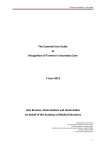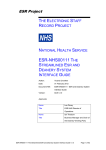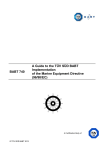Download The Essential User Guide to Recognition of
Transcript
The Essential User Guide to Recognition of Trainers in Secondary Care Julie Browne, Alison Bullock and Derek Gallen on behalf of the Academy of Medical Educators November 2013 The Essential User Guide to Recognition of Trainers in Secondary Care Who’s this guide for? This guide is aimed at secondary care trainers in four key roles who are seeking to have their trainer status recognised locally and, in due course and subject to legal change, approved by the General Medical Council (GMC). It is relevant to trainers in secondary care throughout the UK. This user guide will also be helpful to those who are responsible for appraising trainers. It consists of a series of key questions and answers set out in eight sections. Background to this Guide Page 2 Who is taking part? Page 4 The Standards Framework Page 5 Preparing for Recognition Page 6 Producing your Supporting Evidence Page 7 Continuing Professional Development as a Trainer Page 9 Leaving the System Page 11 Is Recognition Right for Me? Page 12 “Training is patient safety for 30 years” (1) 1 | The Essential User Guide to Recognition of Trainers in Secondary Care SECTION 1: Background to this Guide 1. Why does the GMC wish to recognise and approve trainers in secondary care? 2. When did the new arrangements come into place? The GMC has set out plans to recognise four key groups of doctors in secondary care who are responsible for the training of medical students and other doctors. It will check that its required standards for secondary care training are met, through quality assurance activity. The trainer recognition process is a key component of the GMC’s regulatory framework designed to provide assurance to patients and others that medical education and training produces doctors with the appropriate knowledge, skills and behaviours. This is consistent with paragraphs 39-43 in Good Medical Practice 2013 (2) which set out what is expected of doctors with regard to teaching and training. Doctors: Q should be prepared to contribute to teaching and training doctors and students; Q must make sure that all staff they manage have appropriate supervision; Q must be honest and objective when writing references, and when appraising or assessing the performance of colleagues, including locums and students. References must include all information relevant to their colleagues’ competence, performance and conduct; Q should be willing to take on a mentoring role for more junior doctors and other healthcare professionals; Q must support colleagues who have problems with their performance or health. But they must put patient safety first at all times. This Guide is supplementary to the GMC’s guidance to all doctors on professional standards in medical education and practice, including Leadership and Management for All Doctors. (3) New arrangements have been introduced for the formal recognition of medical practitioners who are also trainers (4) from 2013. By 2014 Education Organisers (EOs) such as LETBs/Deaneries and medical schools across the UK had schemes in place for the recognition of trainers in four key roles. 3. What are the ‘four key roles’? The GMC identifies four key trainer roles. The four roles are: 1) Named educational supervisors: doctors who are responsible for the overall supervision of doctors in training and their progression during placements. They work with doctors in training to plan their training against the agreed learning outcomes. 2) Named clinical supervisors: doctors who are responsible for overseeing the work of the trainee throughout the placement. 3) Those doctors responsible for overseeing undergraduate medical students’ progress. There is at least one in each medical school and, for example, the role may be fulfilled by an NHS consultant or clinical academic coordinating the course. 4) Lead coordinators at each local education provider (LEP): doctors who are responsible for coordinating the placement training and ensuring worthwhile educational activities. If you are a doctor and performing at least one of these four roles, you will need local recognition and, eventually, GMC approval. This applies whether you are a GP, a consultant or an SAS doctor. GP trainers of GP registrars are already approved by the GMC. Named placement supervisors in non-clinical settings (such as public health, occupational or pharmaceutical areas of medicine) also require recognition. “The quality of medical practice and the safety of patients are crucially dependent on the (4) quality of the training provided to medical students and trainees.” The Essential User Guide to Recognition of Trainers in Secondary Care | 2 SECTION 1: Background to this Guide 4. What does ‘named’ mean in this context? All clinicians who come into contact with doctors in training are involved in their education. They do this through being available, observing the doctor in training, teaching on-the-job, giving regular feedback and providing rapid responses to issues as they arise. However, within a given training placement, each doctor in training should have a ‘named clinical supervisor’ and a ‘named educational supervisor’. These named individuals are specifically responsible for individual trainees or groups of doctors in training. Sometimes, both roles may be performed by one person. 5. What is an ‘Education Organiser’ (EO)? The Education Organiser (EO) is the organisation that is responsible for leading the planning and commissioning of medical education and training, such as a Deanery, LETB, medical school or equivalent. 6. What is a ‘Local Education Provider’ (LEP)? A Local Education Provider (LEP) is any organisation that provides learning experiences or environments for medical students and doctors in training on undergraduate and postgraduate medical training programmes. These are usually NHS Trusts and Hospitals or equivalent, but can also be charities/hospices, industry or private organisations, clinics or GP practices. The EO may delegate some of the tasks involved in recognition to the LEP, but the final responsibility for making sure that all tasks have been completed lies with the EOs. 7. What is the difference between ‘recognition’ and ‘approval’? EOs are responsible for identifying their trainers in each of the four categories who will need to be recognised, to provide support to them, to collate required information and to collect the relevant information about them. Once this is done, the trainers will be categorised as either ‘provisionally’ or ‘fully recognised.’ The GMC is currently seeking statutory powers so that this process of recognition becomes a formal approval process, as is the case in general practice. 3 | The Essential User Guide to Recognition of Trainers in Secondary Care SECTION 2: Who is Taking Part? 8. Does recognition apply to me? At present, the GMC is not requiring recognition if you do not hold one of the four key roles set out in the guidance. However, you may still need to be recognised under local arrangements set by your postgraduate Dean, medical school or local EO. You may also seek recognition voluntarily. The GMC’s position is inclusive and it is good practice to expect all trainers to be subject to quality standards. 9. Are all consultants clinical supervisors and as such, do we all need recognition? Nearly all consultants teach medical students and trainee doctors and most are also involved in various types of workplace-based assessment. To that extent they are clinical supervisors. Not all, however, are named clinical or educational supervisors. At present, the process only covers named clinical supervisors and educational supervisors and designated undergraduate clinical leads. Named clinical supervisors oversee a trainee’s clinical work throughout a placement and contribute to the final decision on whether a trainee should progress to the next stage of training by undertaking assessments and providing reports. Named educational supervisors are responsible for the overall management and supervision of a trainee’s educational progress during a placement or series of placements. They are responsible for the educational agreement and for bringing together all relevant evidence in order to assist the Annual Review of Competence Progression (ARCP) panel in making a final decision on whether a trainee is ready to progress to the next stage. 10. I perform more than one of the four roles. How will it work for me? Arrangements for your recognition are negotiated locally. Systems that allow for ‘cross recognition’ between your roles and the EOs responsible for recognising you within those roles will depend on local agreements. Your EO will be able to let you have further details. Generally speaking, organisations are not looking for you to duplicate recognition processes. 11. I’m a doctor with some responsibility for training but I’m not in one of the four groups on the list. Do I need recognition? The GMC does not require recognition beyond the four roles, but your local EO may do so. In addition, if you are planning to apply for a teaching role, or even if you would simply like to get further involved, your local EO may still allow you to apply to have your skills and experience recognised under the scheme. 12. I’m an SAS doctor and my colleague works less than full time. Does it apply to us? If you are undertaking one of the four roles, yes. 13. I’m a locum . . . what about me? Locum doctors currently fall outside the scope of the recognition requirements, but you should check with your local EO as there may be some local variation and the situation may change over time. In addition, these GMC requirements do not apply to doctors who supervise doctors in training for specific sessions but who are not the named clinical supervisor. 14. Can I be approved to supervise doctors in training outside my clinical specialty? Yes. It is not essential that you work in the same specialty as your trainees. What is essential is that you understand the training requirements and processes so that you can fulfil the trainer role. This also means having competence in the area and greater experience than any doctor in training whom you are assessing. (3) “Being an accredited trainer will be a badge of honour reserved for the very best.” (5) (HEE 2013) The Essential User Guide to Recognition of Trainers in Secondary Care | 4 SECTION 3: The Standards Framework 15. What are the standards against which I will be recognised and approved? The GMC requirements relate to seven areas drawn from the AoME Framework for the Professional Development of Postgraduate Medical Supervisors (6). These are: 1) ensuring safe and effective patient care through training 2) establishing and maintaining an environment for learning 3) teaching and facilitating learning 4) enhancing learning through assessment 5) supporting and monitoring educational process 6) guiding personal and professional development 7) continuing professional development (CPD) as an educator Clinical supervisors do not need to show evidence of meeting standard areas 5 and 6 although they should be aware of them. Trainers in the other three groups must meet all seven areas. The framework has been mapped to both The Trainee Doctor (7) and Tomorrow’s Doctors (8). It is up to EOs to determine if, as a trainer, you have met these standards. Individual EOs will define how the standard areas can be met, and requirements may vary. 16. Who decides whether I meet the standards? If you are a named educational or clinical supervisor then the senior responsible officer in your EO - your postgraduate Dean, or his or her equivalent – has responsibility for deciding whether you should be recognised as a trainer. If you oversee student progress at your medical school or are a lead coordinator of education and training where students have placements, then the Dean of the medical school or his or her equivalent within the EO, has responsibility for deciding whether you should be recognised as a trainer. EOs will set the requirements that trainers need to meet. This will at least in part be evidenced through the existing appraisal process, although the exact process will vary between EOs. Appraisal can take place through your normal NHS appraisal process and a separate “educational appraisal” is not needed, although some EOs may choose to establish a specific process. The sharing of responsibilities between LEPs and EOs can be agreed locally. It is up to the EO to determine the criteria by which trainers’ performance against the GMC standards are judged. 5 | The Essential User Guide to Recognition of Trainers in Secondary Care SECTION 4: Preparing for Recognition 17. Will I need special briefing on the recognition process before I begin? The system is designed to be simple and constructive, so you shouldn’t need specific training to get started, although your EO may run short orientation sessions in your local area to brief you about the process. 18. Before I begin the process, what do I need to have in place? To undertake the trainer recognition process, you need to hold valid registration and a licence to practise. You need to undertake CPD and demonstrate appropriate attitudes and behaviour. If you train senior doctors in training your postgraduate Dean may require you to be on the Specialist Register. 19. How will the recognition process work in my local EO? Each EO has developed its own detailed plans for recognising its trainers and will communicate these to you. Whatever individual systems your local EO has in place, however, one thing will be common to all: to gain recognition you must be ready to talk about what you do as a trainer and provide evidence that you are meeting the standards framework (see Q. 15). Bear in mind that the primary focus of the recognition scheme is on your work as a trainer (rather than as a clinician, researcher or medical manager). So you will need to supply evidence of your commitment to, and achievements in, the education and training of medical students and trainee doctors, structured against the relevant GMC standard areas. 20. Who will assure the quality of my EO’s recognition processes? 21. I am a Member or Fellow of a professional organisation for medical educators. Can I be exempted from all or part of the recognition process? Some EOs have indicated that membership of certain external accrediting bodies such as the Higher Education Academy (HEA) and AoME may count as full or partial evidence that you are meeting the GMC standards for trainers, especially where these have been mapped against the seven GMC standards areas. You need to check the requirements of your individual EO; these requirements may change as the process becomes more established. Whatever your local EO’s view on this, the fact that you take your CPD as a trainer seriously enough to have applied for accreditation from an external professional body will help you considerably when grouping your evidence in preparation for recognition. In the case of AoME, membership has been mapped against the GMC standards for trainer recognition and can provide additional evidence that you meet or exceed these. 22. I’ve been teaching for quite a few years now but I’ve never done any CPD in teacher training . . . will that be a problem? The GMC and the EOs are aware that there will be a lot of people in your situation right now, so the system is designed to be relatively ‘lighttouch’ at first. Your EO will be able to tell you what its requirements are for CPD evidence; these will vary between EOs and may also change and develop over time. The GMC has overall responsibility for assuring the quality of EOs’ recognition processes (9). “It is a virtuous circle - better supervision will lead to better trained doctors will lead to improved patient care. (AoMRC)” (10) The Essential User Guide to Recognition of Trainers in Secondary Care | 6 SECTION 5: Producing Your Supporting Evidence 23. What if I don’t meet the requirements? You may not at first be able to supply all the supporting evidence that your employer needs to recognise you fully as a trainer. If this is the case, your recognition will be ‘provisional’ rather than ‘full’ while you seek further evidence. However, the GMC says that all trainers in the four categories must be fully recognised by 31 July 2016 and local arrangements may be more stringent, so you will need to check with your EO. 24. Is the supporting evidence required the same as for revalidation? Broadly speaking, yes. The trainer recognition process will complement both the revalidation and NHS appraisal processes, and if you are preparing for these, you should already be collecting evidence of your teaching and CPD activity. Detailed information requirements for appraisal will be determined by your employer and detailed information requirements for recognition as a trainer will be determined by your EO. The employer and the EO should work together to ensure a good fit. 25. How can I gather supporting evidence on my teaching activities? Your local EO will advise in more detail about what attributes you will be expected to demonstrate. There will be four main sources of evidence for these: 1) your students or doctors in training, 2) your colleagues and peers, 3) your own reflections, 4) your record of CPD as a trainer. 26. How can I get feedback from my students or doctors in training? There are all sorts of ways, direct and indirect – here are some suggestions: Q Ask doctors in training or students for copies of their notes so you can check if they understood. Q Ask questions while you teach to see if your doctors in training are following you. Q Ask for verbal feedback about your teaching. When you do this, try to get specific feedback by asking targeted questions, such as ‘Did you find the examples I gave helpful?’ ‘Could you follow the slides?’ ‘Did you have enough time to finish the task?’ ‘Would you have liked the handouts before the session?’ Q Give quizzes, assessments and short tests at the start and end of the teaching session to check the progress of the doctors you are training. A word of caution regarding test results: even if trainees do well in tests and exams, this isn’t necessarily a sign that your teaching (or assessment practice) can’t be improved! Q Ask your students or doctors in training to write a very short note (one minute) about the things they have learned. Q Ask your students or doctors in training to fill in a feedback questionnaire. Getting feedback from trainees and students is ordinary good practice in teaching, and you are probably doing some or all of these things already; if so, keep a simple record of the feedback you get and use it to reflect on your performance. 27. How can I get feedback from my colleagues and peers? Although it isn’t always easy to find the time, it does help to exchange ideas on education with other trainers. Here are some ideas: Q Ask a colleague or two to observe you as you work with a trainee or student in a learning situation. If you can offer to do the same for them, a useful dialogue can result. If your colleague can’t attend your teaching session in person, you could videotape or stream it and get their comments afterwards. It is good 7 | The Essential User Guide to Recognition of Trainers in Secondary Care practice to make sure that your trainees (and where relevant, patients) have agreed to this well in advance. Q If you are undertaking 360-degree appraisal, make sure that you include your teaching role as a specific area for feedback. Q Write a report of something you have done and show it to a colleague for comment. You could also submit it to a conference as an abstract, presentation or poster, post it as a blog, or send it to a web-based or print journal, or other medium where it will be peer reviewed. Q Submit your education portfolio to a professional body that recognises teaching such as the Academy of Medical Educators, the Higher Education Academy or your Royal College or Faculty. 28. I reflect on my clinical practice as a matter of course, but I don’t really know how to reflect on my teaching. If you take a scholarly and reflective approach to your clinical practice, you probably already have all the skills you need to reflect on your work as a trainer. Some LETBs/Deaneries and medical schools may offer training and most have an electronic portfolio system in place to help you store your reflections and evidence and plan your personal development. But if you’re still stuck, you can do it yourself. Just ask yourself a few straightforward questions about a recent incident or event that occurred while you were helping someone to learn and, using your own words, jot down your thoughts. You might find the following questions provide a useful structure for noting down your reflections (11): 1) What was the setting/context? • Who was there (e.g. one-to-one with a trainee; small group; co-worker)? • What was the nature of the environment (e.g. quiet room, lecture theatre, at the bedside, in or away from the workplace?) • What was your role (e.g. educational supervisor, placement organiser, progress reviewer, etc.)? 2) What did y`ou do? • Describe something that you did personally, rather than what you saw or witnessed. 3) Why did you do it that way? • Describe the reasons or evidence on which you based your decision to do it that way. For example, you may rely on previous experience, advice from colleagues, published evidence, student feedback, regulatory guidance, or it may be entirely your own idea. 4) What was good about the way you did it? • Explain how what you did improved learning, drawing attention, where possible, to how this benefited patients and students. 5) What might have been improved? • What would/might you have changed about what you did? 6) What was the overall effect or result of what you did and how do you know? • What evidence can you provide that this was the effect or result? Personal impressions are acceptable, but it is helpful if you can produce evidence in the form of learner or colleague feedback, published data, audit and assessment results or other written evidence. 7) What does this experience tell you about teaching and learning in general? • What general lessons have you learned that you could use in future? 8) What will you do differently as a result? • What will be the practical result of your reflection? What actions will you take? When will you take them? When you’ve collected a few of these thoughts and bits of supporting evidence, preferably over a period of time, think about how you might group them against the seven (or five, if you are a clinical supervisor) required standard areas in preparation for any appraisal meeting or interview during the recognition process. You will begin to see for yourself the overall areas in which you feel confident and those in which you might want to develop. “Clinical supervisors should be the epitome of excellence as self-reflective doctors as well as teachers.” (10) The Essential User Guide to Recognition of Trainers in Secondary Care | 8 SECTION 6: Continuing Professional Development as a Trainer 29. How can I select appropriate CPD for my trainer role? There are many sources of training for medical teachers available from part time and distance learning, to short courses, workshops and postgraduate award-bearing qualifications. Your EO may well support you to undertake some of these and will also be able to point you in the direction of the training that is most suitable for your needs. Look for courses and educational events that have clear learning outcomes (preferably mapped against the GMC standards framework areas), appropriately qualified and experienced leaders, are adequately resourced with a variety of teaching and learning modalities, appropriate and helpful assessment methods, and preferably those which are formally accredited - by your local EO, a higher education institution such as a University, or by a Royal College or professional body such as AoME. As the process beds down, you will probably find that increasing numbers of teacher and trainer development courses are mapped against the standard areas so that you will find it easier to identify CPD opportunities that refresh and increase your knowledge within particular standards. This will enable you to be more systematic and targeted in your personal development and private study. It will help employers to identify learning needs among their workforce and help education providers to ensure sufficient appropriate training is available. Keep a record of the CPD activities you undertake (including informal self-study, such as personal reading) and be prepared to discuss why you did them, what you got out of them, and what effect they will have on your practice as a trainer. 30. How much CPD is required? This varies between EOs. Some use a tariff system, some specify an amount of training. In Wales, for example, trainers are required to undertake a set annual number of hours of CPD related to their educator role, and must do a certain number of hours per standard area in any five-year cycle. A proportion of this CPD must be verifiable through an approved educational accreditation system: the rest can be unaccredited or informal study, but it should still be documented and evidenced. 31. How can I decide what CPD I need? Your postgraduate Dean, medical school or EO will advise you on the minimum requirements for the purposes of recognition. If you wish to study medical education theory and practice in more detail, there is already a great deal of CPD on offer. One of the advantages of the GMC standards framework is that it will help you to decide what areas of knowledge and skill you need to refresh and to look out for courses in those areas. Many EOs provide training courses aligned to the GMC standards framework areas. This should help you to identify the courses and workshops that are most suitable for you. 32. Where can I access CPD in medical education and training? Check with your local postgraduate Dean, University, Royal College or NHS employer for what’s available. You will be able to find courses to suit your preferences for on-line, face-to-face or blended learning. Courses range in duration and level from short ‘train the trainers’ workshops right up to Master and Doctorate level. There are a variety of people you can ask for advice about what’s available and likely to suit your needs Departmental Royal College Tutors, local Training Leads, and Training Programme Directors within specialty schools, Deanery/LETB leads for faculty development, Undergraduate Deans or Directors of Medical Education, or faculty development leads in your local medical school or university. 9 | The Essential User Guide to Recognition of Trainers in Secondary Care 33. I did a significant amount of CPD in education a few years ago: is that enough? This demonstrates evidence of past commitment to your personal development; you are one of the many dedicated clinical trainers and supervisors who have undertaken voluntary additional training ranging from short courses right up to postgraduate degrees in medical education. Evidence of such training is an important indication of your skills and knowledge and will indeed be very useful towards obtaining early full recognition. have been keeping your CPD in medical education up to date by reading and studying the literature, attending meetings and courses and reflecting on and evaluating your own practice. If so, you will find the recognition process relatively straightforward. If you haven’t, then it’s probably time you thought about refreshing your knowledge and skills. 34. Who will pay for my training? Many training courses will be provided free of charge. You should seek reimbursement for travel and subsistence from your employer. However, skills in education, like skills in clinical practice, need to be constantly revisited. Curricula content, assessment methods and expected outcomes also change. The likelihood is that, following your course of formal study, you The Essential User Guide to Recognition of Trainers in Secondary Care | 10 SECTION 7: Leaving the System 35. What if I don’t achieve recognition? If you really want to continue as a trainer in one of the roles requiring recognition and are prepared to engage with your EO’s processes, then you will probably be offered provisional recognition to give you time to meet any remaining requirements. If questions arise about your teaching commitment, or the quality of your supervision or coordination role, it is expected that your postgraduate Dean or medical school will liaise with your Trust/Health Board to address concerns. At that stage, it may be appropriate to put in place some form of remediation, or it may be agreed that you no longer undertake that training role. 36. Can I appeal if I don’t get full recognition? Your EO will be able to let you have details of its appeal procedures. It’s important, however, to bear in mind that this is not a high stakes exam or a hoop to jump through. It is part of a continuous process designed to help and encourage you to improve your practice as a clinical trainer. For employers, its purpose is to help them to keep track of their clinical training workforce and to ensure that their trainers are keeping their continuing personal and professional development (CPPD) up to date. So if you don’t get full recognition at first, it’s an opportunity to review what you wish to do in education and training. Provisional recognition simply indicates that you are working towards full recognition but haven’t yet produced the required evidence. 11 | The Essential User Guide to Recognition of Trainers in Secondary Care SECTION 8: Is Recognition Right for Me? 37. This all looks like a lot of hard work, just to do something I’ve already been doing for ages. What’s in it for me? It is worth stressing that although it may at first look like hard work, it doesn’t need to be! Just as with revalidation and evidence supporting good clinical practice, the challenge is simply to be aware of the need to produce evidence as you go along. A good trainer will already be demonstrating appropriate attitudes and behaviours and keeping up to date with new developments in the field of medical education. All you have to do is collect evidence of this as you go along. The recognition process is your chance to have your skills and achievements as a trainer formally recognised by your employer, possibly for the first time. The recognition system is only the first step in a programme of work designed to ensure that job planning, resource allocation and service load all reflect the responsibilities undertaken by trainers on a day-to-day basis. 38. I have enough of a clinical and teaching workload without this . . . I would prefer to concentrate on my clinical practice. As a doctor, you care about providing good patient care. If you also believe that good medical training leads to better doctors who can provide excellent clinical care in the future, and that clinicians have a vital role to play in improving the quality of the education medical students and doctors in training receive, then this is good reason to involve yourself in this process. However, it isn’t compulsory. Only you can decide if you want to participate in the scheme; if you don’t seek recognition you will still be able to teach (at least for the time being), but you won’t be able to fill one of the four designated roles. 39. I have to train juniors because my clinical practice is so specialised and I am the only one in the region who can do it. What would happen if I didn't seek recognition? Only those who are recognised (and, when the GMC has secured the necessary statutory powers, approved) will be able to perform the designated roles related to trainee supervision and the overseeing and coordination of undergraduate medical student placements. This applies however small and specialised the clinical specialty. If you are performing one of the four roles and wish to continue to supervise doctors in training, you must seek recognition. 40. The trainer role is not in my job plan. What can I do? The GMC is clear that LEPs must take responsibility for supporting trainers through their job plans. If you are a trainer and your job plan does not reflect this, you should raise the matter with your clinical director and College Tutor in the first instance if you are providing postgraduate training; and in undergraduate contexts, you should speak to your medical school representative, for example your Clinical Sub-Dean or Honorary Senior Lecturer. 41. I’m still not sure . . . Your first port of call for advice about local arrangements is your EO. There is more detailed advice in the GMC’s Implementation Plan and at www.gmc-uk.org/recognisingtrainers Finally, you can ask the GMC direct for further advice – just email: [email protected] The Essential User Guide to Recognition of Trainers in Secondary Care | 12 References (1) Temple J. Time for Training. London: Medical Education England, 2010 (2) General Medical Council. Good Medical Practice. London: GMC, 2013. (3) General Medical Council. Leadership and Management for All Doctors. London: GMC, 2012. (4) General Medical Council. Recognising and Approving Trainers: The Implementation Plan. London: GMC, 2012. (5) Health Education: England. Our Strategic Intent. Leeds: HEE, 2013. (6) See http://www.medicaleducators.org/aome/index.cfm/profession/edsupervisors/ (7) General Medical Council. The Trainee Doctor. London: GMC, 2011. (8) General Medical Council. Tomorrow's Doctors. London: GMC, 2009. (9) See http://www.gmc-uk.org/education/assuring_quality.asp (10) General Medical Council. Report on the Outcomes of the Consultation on the Approval of Trainers. London: GMC, 2013. (11) See Cardiff RICE https://www.surveys.cardiff.ac.uk/rice1 APPENDIX 1: Glossary of Key Terms Academy of Medical Educators Approval The Academy of Medical Educators (AoME) is the professional organisation for all those involved in medical education – the education and training of students and practitioners in medicine, dentistry and veterinary science. Established in 2006 and gaining charitable status in 2009, the Academy exists to provide leadership, promote standards and support all those involved in the academic discipline of medical education. AoME developed the Framework for the Professional Development of Postgraduate Medical Supervisors which forms the basis of the recognition process. The process by which the GMC will hold the names of approved trainers. Currently the GMC approves only GP trainers of GP registrars but it is seeking statutory powers to extend its approval to other trainers. Appraisal The process of collecting and reflecting on information relating to a doctor’s educational practice, followed by a discussion with an appraiser at a formal, confidential meeting. The purpose of appraisal is to support doctors’ personal and professional development throughout their careers. An appraisal meeting between the appraiser and the appraisee should take place every year. 13 | The Essential User Guide to Recognition of Trainers in Secondary Care Clinical supervisor Local Education Providers (LEPs) The clinical supervisor is responsible for day-to-day supervision in the workplace. Clinical supervision involves being available, looking over the shoulder of the trainee, teaching on-the-job with developmental conversations, regular feedback and the provision of a rapid response to issues as they arise. All doctors in training should have a named clinical supervisor for each post (though there may be contextual differences between specialties), who must be able to tailor the level of supervision to the competence, confidence and experience of their trainee. These are usually NHS Trusts and Hospitals but can also be charities/hospices, industry or private organisations, clinics or surgeries. Recognition The process by which EOs will identify the essential contributions of appropriately trained and experienced doctors who are responsible for the education and training of medical students and/or doctors in training. Recognition can be full or provisional. Revalidation Education Organisers The Education Organiser (EO) is the organisation that is responsible for leading the planning and commissioning of medical education, such as a Deanery, Local Education and Training Board (LETB) medical school or equivalent. Educational supervisor The educational supervisor is responsible for the supervision of a trainee’s progress over time. Educational supervisors are responsible for ensuring that doctors in training are making the necessary clinical and educational progress. Educational supervisors need all the skills of clinical supervision, plus an appreciation of supporting educational theory, the ability to undertake appraisal, work with portfolios and provide careers advice. Managing the trainee in difficulty will also, inevitably involve the educational supervisor with support from the EO’s training structures. General Medical Council (GMC) The GMC is a UK-wide body whose purpose is to protect, promote and maintain the health and safety of the public by ensuring proper standards in the practice of medicine. It has four main functions under the Medical Act 1983: 1. keeping up-to-date registers of qualified doctors The process that commenced on 3 December 2012 by which all doctors in the UK show to the GMC that they are up to date and compliant with the relevant professional standards. All doctors with licences to practise are legally required to be revalidated every five years to continue practising in the UK. In addition, they are required to complete annual appraisals based on the GMC’s core guidance Good Medical Practice (2013)(2) and evidence from these appraisals will be used to inform the revalidation process. Most licensed doctors should have undergone revalidation by the end of March 2016. Supporting evidence During their annual appraisals, trainers will use supporting information to show that they are continuing to meet the standards set by the GMC as mapped against the AoME seven framework areas.(2) Trainee The GMC defines a trainee as any doctor participating in an educationally approved postgraduate medical training programme and holding a funded post (Foundation Programme or specialty including GP training). A medical student is not, by this definition a trainee, although trainers may in fact teach both medical students and doctors in training. The GMC’s plans for recognition of trainers cover both postgraduate training and undergraduate education. 2. fostering good medical practice Trainer 3. promoting high standards of medical education and training The GMC defines a trainer in general terms as ‘a more experienced clinician who provides training and educational support for a learner.’ By this definition, the four key roles set out in this Guide are all trainers. 4. dealing firmly and fairly with doctors whose fitness to practise is in doubt. The Essential User Guide to Recognition of Trainers in Secondary Care | 14 The Essential User Guide to Recognition of Trainers in Secondary Care The information in this Guide is correct at the time of printing and may be subject to change. This is not intended as legal guidance, but instead is intended as a training aid. For policy guidance please go to the General Medical Council’s website: www.gmc-uk.org This Guide was commissioned from the Academy of Medical Educators by Health Education England and the General Medical Council. This version replaces all earlier drafts. Acknowledgements The authors and the Academy of Medical Educators are grateful to the many people who contributed towards the preparation of this Guide. They particularly acknowledge the assistance of Mary Beech, Sally Blake, John Bligh, Ian Curran, Sean Hilton, Sian Lewis, Vicky Osgood, Suzanne Phillips, Anton Saayman and Lee Wisby. To cite this Guide: Browne J, Bullock A, and Gallen DD. The Essential User Guide to Recognition of Trainers in Secondary Care. November 2013. Cardiff: Academy of Medical Educators on behalf of Health Education England and the General Medical Council. Wales Deanery | January 2014





























